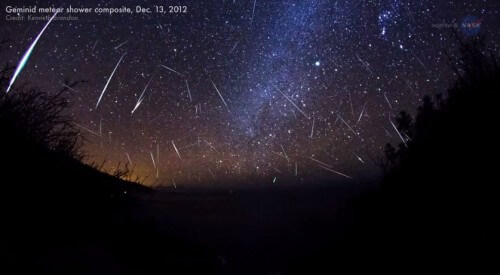The origin of the Geminids is a new type of celestial object - a rocky comet, an asteroid whose orbit is elliptical and it comes very close to the sun and therefore heats up and emits stones and dust

December 12th has arrived, and for amateur astronomers this means it's time for the annual Geminid meteor shower. Every year in early December the Earth passes through a stream of dusty debris from the rocky comet Phaethon 3200 (3200 Phaethon). This transit causes a meteor shower that sometimes lasts more than two weeks.
"This year's Geminid shower will peak on December 13 and 14, and the forecast is for records of up to 120 meteors per hour," predicts Bill Cook, head of NASA's meteorite affairs office. "I'm looking forward to a beautiful display."
We've all heard of comets - icy visitors from the outer solar system that have long tails of gas and dust as they approach the Sun. One of these is currently being studied by the European spacecraft Rosetta, which also landed the Philae lander on its surface, which unfortunately landed in a shady spot and cannot recharge its batteries and continue the fruitful research it conducted for 60 hours, but what is a rocky comet?
A "rocky comet" is a new class of objects whose classification is being debated by astronomers. In principle, it is an asteroid that comes very close to the sun - so close that the burning of the sun causes the material on its surface to emit fragments of rock. Thus rocky comets can also grow comet tails, from which the meteors that fall to Earth are eventually formed.
The source of the Geminid meteor Phaethon 3200 looks more like an asteroid and indeed it comes from the asteroid belt. Its color is also similar to the color of other asteroids in the asteroid belt between Mars and Jupiter. However, Phaethon 3200 has an unusual orbit that brings it deep into the orbit of Mercury. When this happens, the comet begins to glow and emit something that looks like a comet imitation. A team of astronomers led by UCLA's Dave Jewitt has already observed Phaethon 3200 using the stereo twin spacecraft that normally study the Sun. They believe that powerful solar flares heated the asteroid's surface and caused Phaethon to spew meteors like whispering embers spitting embers in a large bonfire.
The Pathon 3200's debris stream is wide and massive. "Of all the debris streams that the Earth passes through every year, the Geminids is the widest and most massive," says Cook. "When you calculate the amount of dust in the Geminid stream, you see that it is 5 to 500 times greater than other meteor streams.
The Geminid meteorite is coming to us, as the name of the constellation Gemini suggests. They hit the atmosphere at a speed of 35 kilometers per second or 78 thousand km/h. It might sound fast, but it's actually somewhat slow compared to other meteor showers. Gadminid meteors tend to be long and bright and produce many fireballs on the nights around the meteor peak.
The best time to watch meteors, advises Cook, is between midnight local time and sunrise on the night of the 13th and the night of the 14th of December, when a group of twins is high in the sky and shoots bright embers of rocks at us that appear in the starry sky.
